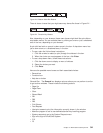SNDTCPSPLF command in the control file. The receiving system creates the
spooled file under this user profile with a job name of QPRTJOB. If the user profile
does not exist, the system uses the default user profile QTMPLPD. You can prevent
user IDs that do not exist on the receiving system from sending with LPR by setting
the *PUBLIC access of QTMPLPD to *EXCLUDE.
When the destination is an AS/400 system, the specified print queue value (PRTQ
parameter) can be the name of any defined output queue on the destination AS/400
system. You need to specify the full library name and output queue name when
sending to another AS/400 system. If you do not specify a library name, the system
searches the library list that is associated with the user ID. If it does not find the
output queue or if the user ID is not authorized to it, the system uses the default
output queue of QPRINT in library QGPL.
If the file is transformed to ASCII, the extended print attribute is not sent in the
control file. The transform program uses the spooled file attributes to produce an
ASCII print data stream that is specific to the specified printer model parameter.
The spooled file is created on the receiving AS/400 as type *USERASCII with
default attributes. Also, the spooled file name is changed to LPDxxxx where x
represents any valid hex character. This forms a unique signature that identifies the
LPR client that sent the file.
How the System Sends a Spooled File from an AS/400 System to a
Non-AS/400 System
When using SNDTCPSPLF or LPR to send a spooled file to a non-AS/400 system,
it is sometimes necessary to refer to the LPD documentation for that
implementation to determine the print queue value (PRTQ parameter). For example,
the print queue value for the OS/2 licensed program is the physical name of the
destination printer object on the desktop.
Note: On some systems, the name of the destination printer queue is case
sensitive. If the name of the destination printer queue is lowercase or mixed
case, enclose the name in apostrophes (‘ ’) to prevent the AS/400 system
from making the name uppercase. This also applies to the
destination-dependent options.
When sending to non-AS/400 systems, the LPD server reads the control file that
contains a number of printing options and attributes, such as width of output and
number of copies. Only attributes that the LPR/LPD protocol supports are sent. In
particular, the page range-to-print attribute is not supported. The LPD server
determines the implementation of the control file attributes. This control file is part of
the LPR/LPD protocol, and LPR builds it automatically.
Number of copies
For the number-of-copies attribute to function properly, you must send it in a way
that the LPD server recognizes. The default method puts a print command in the
control file for each copy requested. A single copy of the data and control files are
sent. Some print server LPDs require this method, but most LAN-attached printers
ignore the multiple print commands.
The alternate method puts a single print command in the control file. The data and
control files are then sent multiple times. To select this method, press F10 to display
Chapter 11. Line Printer Requester (LPR) 349


















